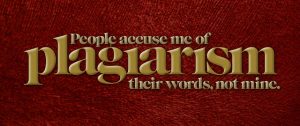130 11.7 Plagiarism
As we have discussed in previous lessons, it is critical for you to give appropriate credit through footnotes or source attribution for ideas and information that you use in your writing. Further, the issue of plagiarism is very serious. It is crucial, then, that you learn the proper method for crediting the source of your information, no matter where it came from.

Ignorance about what is and is not plagiarism is not a good excuse for committing plagiarism, nor is it likely to stand up as an excuse that others will believe. In cases where you are not sure if you’re drifting into the realm of plagiarizing material, you are much better off citing the information and providing quotation marks when appropriate rather than making it seem as if you are representing another’s work as your own.
The synthesis step provides you with the last chance to identify missing information, catch errors, and make final decisions about the shape of the message. Along with the message analysis step that starts the information strategy process, the synthesis step is the most difficult task you face in your message process.

